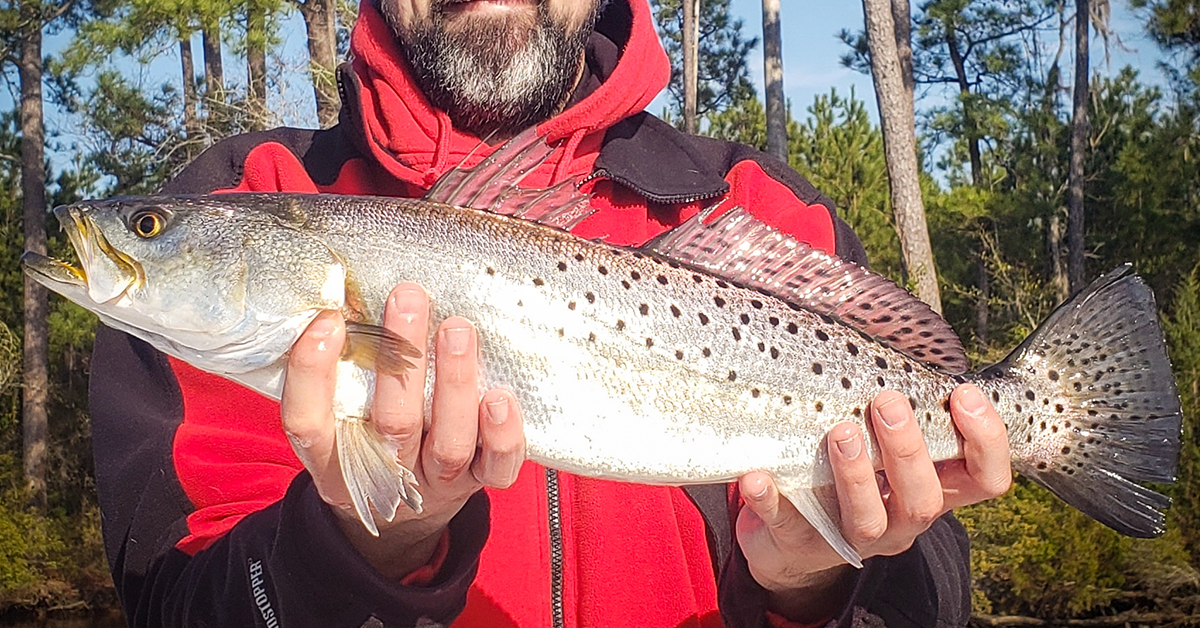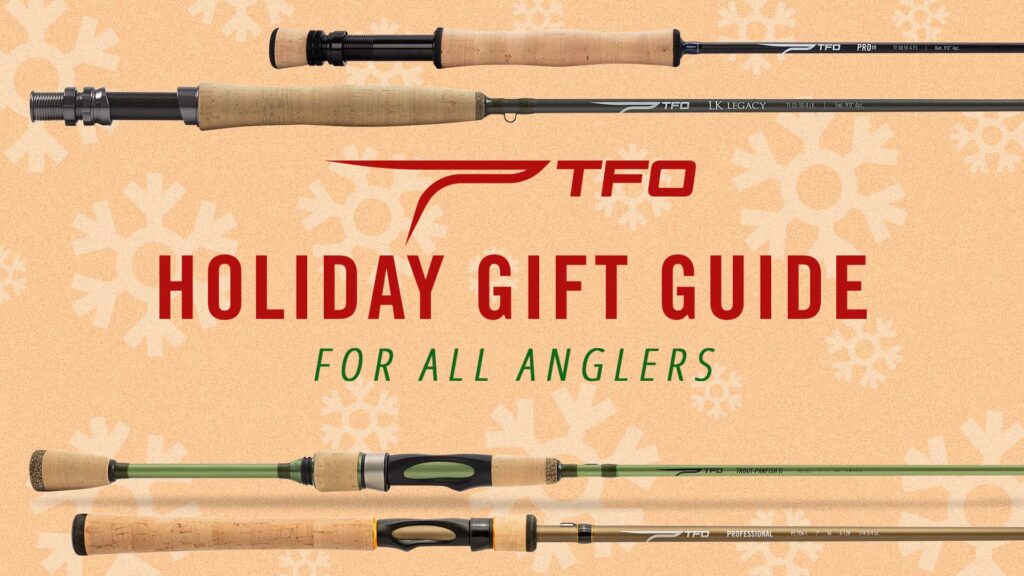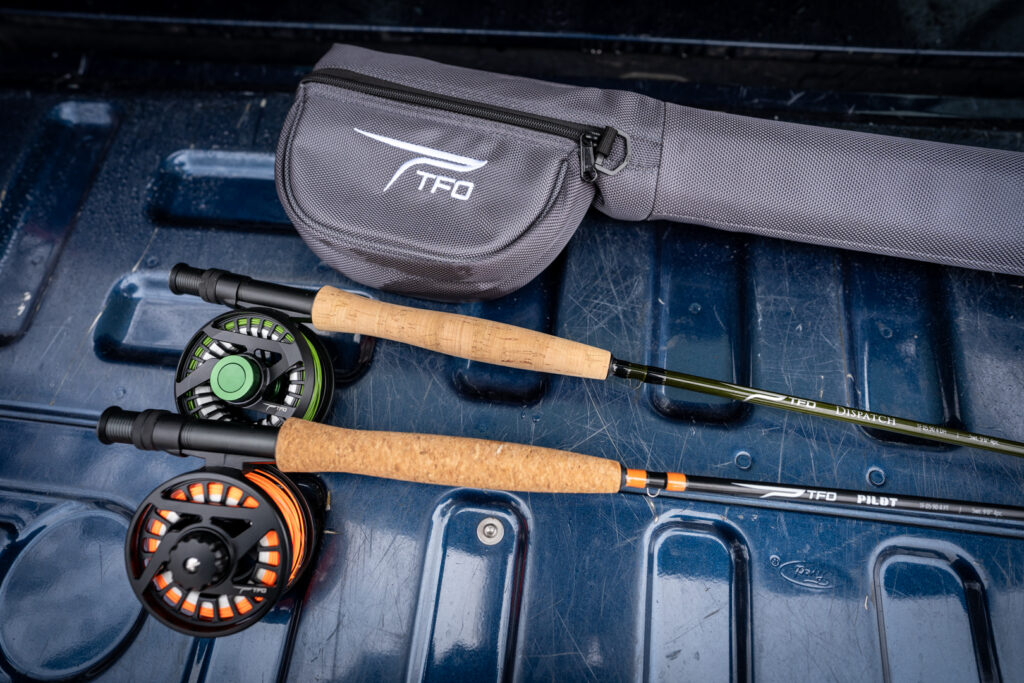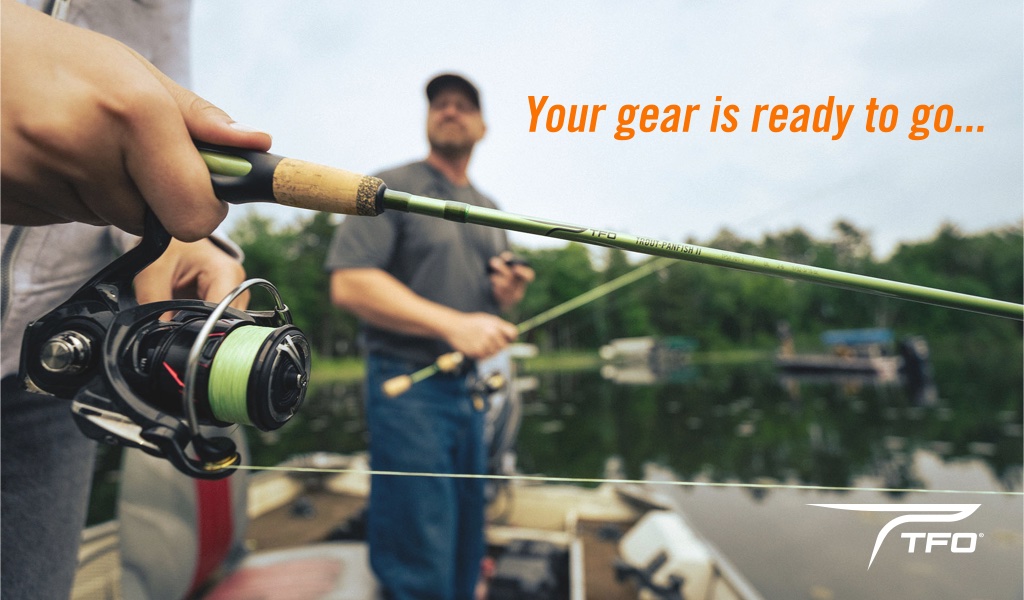When not chasing after striped bass and redfish in the Pamlico Sound and estuaries of coastal North Carolina, TFO National Advisor Capt. Gary Dubiel (Spec Fever Guide Service) loves to put his clients on large speckled sea trout. Even during the cold winter months, Gary knows how to find speckled trout and has some excellent tips for both fly and conventional anglers.
The Pamlico Sound & The Migration of Coastal North Carolina Speckled Trout
TFO: Tell us about your fishery briefly and why it’s suitable for speckled trout.
GD: The Pamlico Sound estuary system is fairly giant – 2.1 million surface acres of water. You’re basically looking at a shallow inland sea. It’s very conducive to speckled trout just from an environmental point of view – lots of shallow water, nursery area, and an abundance of food. It will also hold enough ideal water temperatures where the fish are going to be in the area year round.
Speckled trout here in North Carolina are very different then ones you’ll find in Florida, Louisiana, or Texas in that they have a significant migration distance. Many of the fish we have here will migrate out into the ocean and go north into the Chesapeake Bay.
I’ve been involved in a lot of tagging studies and my furthest tag return was 285 miles away from its starting point in Oriental, NC. Another interesting tag return that I was involved in was a fish I recaptured that was tagged in Virginia. The fish was only 13 inches long and was tracked from Northern Virginia to Oriental, NC and was recaptured within 14 days. These fish can move great distances in very short periods of time, which can make it challenging when trying to locate them.
As a rule of thumb in our river systems (Pamlico River and the Neuse River into the Pamlico Sound), typically what you’re going to find is that the cooler the weather, the more the fish move upriver and into the creeks. In other words, the further back into the creeks you go, the warmer the temps get. You’re typically going to see this pattern in late October/November right up into March/early April.
Once the water temperatures warm up into the low 70s and stay there for a short period of time, those fish will move out of the creek systems and back out into the main river systems. At that point, there can be fish that move to North Carolina from Virginia – move back out into the ocean and up into the Chesapeake Bay.

Photo: Gary Dubiel
Spawning & Average Size
TFO: What are typical spawning or migrating behaviors across the seasons for speckled trout?
GD: Our fish here will adjust and typically move out into the lower parts of the river in the Sounds – where their first spawning will be around the first full moon at the end of May/early June. The first spawn is also going to be related to water temperature – somewhere in the low-mid 70s.
The fish will stay in those areas through the summer into early fall. There will be some shifting, but they are in those general area. Speckled trout can spawn 3-4 times throughout the course of the year. Smaller fish typically spawn twice, larger fish might spawn up to 3 times in a year.
TFO: How big do they get typically and what’s an average size for you?
GD: You can find a mix of fish (size-wise) throughout the course of a year. Typically in the cooler months, bigger fish are more concentrated and more on the aggressive side. They tend to be more willing to eat much smaller baits as the water temperatures drop. Typically, you can catch more large speckled trout (24”-30”) in the cooler months, however, you can still catch big fish all summer long depending on your tactics.
You’ll see a lot of small fish in my area because of the volume of breeding that occurs here – anywhere from 10”-12” fish, right into 20”-24” fish. You’re looking at a pretty significant distribution of fish from one right up about six years old.

Photo: Gary Dubiel
Locating Specked Trout
TFO: How are you typically locating speckled trout in the winter? Where is the best place to target them (river/water location or depth)?
GD: In the cooler months, you’re going to be looking to fish primarily in the creek systems, and the upper parts of the rivers. You basically have two different areas that you’ll find fish during the winter – both are particularly related to water temperatures.
In water less than five feet deep, I can catch speckled sea trout down to about 47.5 degrees (water surface temperature). Typically, in the backs of the creeks (water less than five five deep), the bottoms are dark mud and soft – so they’ll warm up faster in the sunshine. You can get a one to four temperature increase over the course of a sunny day.
In areas that are deeper – around six to twelve feet of water – you can catch speckled trout right down to about 45 degrees (water surface temperature) with your bottom temperature being a few degrees warmer.
The further upriver you go – cities like New Bern or Washington – you’re going to find some of the creeks are much deeper, so you’ll target the fish a bit deeper. Good news for that is that you can fish those with much lower water temperatures in colder conditions – bad news is they don’t warm up. What you have when you start out, over the course of the day is typically what you’re going to have. Those deeper creeks won’t warm up much on sunny days.
Tactics & Set-Ups For Light Tackle
GD: In the winter, you want to fish as light as you possibly can. Allow your baits to sink very slowly and take advantage of a fish that’s pretty lethargic. You’re fishing for them at the lower ends of their tolerance to eat.
Scaling down in weights is helpful. Typically, I will fish down to a 1/16 oz. jig head with soft plastic bodies. I’ll scale down on soft plastic bodies – 2.5-3 inches.
Another bait that works really well for me in the winter is the Storm Shrimp – which is a composite, keel-weighted shrimp pattern. This mean that the weight is in the center of the hook shank, so the baits will fall flat – rather than head first. This results in a decreased fall rate, which can increase the amount of the bites you get.
In order to fish those baits, I want to have the lightest, most sensitive rod I can have. The 6’9” Light Inshore is ideal for that. Typically I’m going to be fishing a 1000-1500 series spinning reel with 8-10 lb. test braid. Everything is really light and scaled down. Even if you catch a striper or a redfish, the water is cold, so those fish aren’t going to peel line off like when its 75 degrees. In the winter, everything is lethargic.

Photo: Gary Dubiel
Tactics & Set-Ups For Fly
GD: You pretty much want to copy the same tactics used for light tackle, and apply it to fly. Typically, I’m fishing Type 2 to Type 3 lines depending on the water depth. You’ll want a slow sinking line, or a clear intermediate line, with a lightly weighted fly.
Rods that fish this type of setup well are the Axiom ll-X, the Axiom ll, and the Mangrove. 6wt and 7wt are what I prefer, but you can also fish up to an 8wt.
Smaller weighted flies such as Clousers, Half & Halfs work great. I also use a few of my own craft fur patterns. The Lil’ Hayden is one I tie that produces well for speckled trout. The Pop-N-Shrimp is another good one. Flymen has reproduced one of my mine called the Crafty Deceiver.
Ultimately, you’re looking for something that has some weight in it, but that falls about the same rate as those slow sinking lines do. Click here for a video where Gary breaks down some of his go-to patterns for speckled trout.
For a reel, the BVK-SD is the perfect tool for the job. It’s lightweight and has plenty of drag if you need it, too.
I usually use a 3’-4’ straight leader to the fly. Usually, I scale down to 15lb fluorocarbon in the winter to help maintain that straight contact with the line and fly.

Photo: Oliver Sutro
TFO: What retrieval patterns typically work best for you?
GD: Strip and Pause. Strip, Strip, Pause – All your bites are going to be on the pause. Pay attention to your counts on your pauses. If you are getting bites on a certain number (seconds you are counting), take note as it gives you an indication of where the fish are and how they’re reacting.
Anything that feels different – strip strike. Even though it is cold, those fish can spit out that fly pretty quickly.
Make sure that the rod tip is almost in the water and pointed at the fly to maintain as direct contact as possible to help detect any strikes.
TFO: Not many anglers are aware that speckled trout have some pretty sharp teeth. Do you have any advice on handling them?
GD: You’ll want to grab them in the belly right under the gills. Don’t put your fingers in their mouth like you would a bass or other species (laughs). You’ll want to have some plies or hemostats to get the fly out of their mouth once you have them at the both.
![]()







